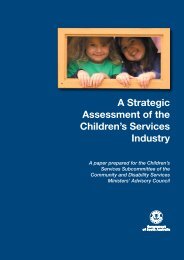Global Study On Child Poverty And Disparities (PDF) - Social Policy ...
Global Study On Child Poverty And Disparities (PDF) - Social Policy ...
Global Study On Child Poverty And Disparities (PDF) - Social Policy ...
You also want an ePaper? Increase the reach of your titles
YUMPU automatically turns print PDFs into web optimized ePapers that Google loves.
Torba are important in terms of helping the most<br />
disadvantaged rural residents, but should not<br />
necessarily be expected to have a significant<br />
impact on overall poverty in Vanuatu. A challenge<br />
for policies to reduce poverty is to determine<br />
ways of helping the poorest while having the<br />
maximum impact on overall poverty.<br />
Figure 2.5 shows that the share of poor children<br />
living in different parts of Vanuatu changes<br />
depending on the poverty line. Based on all<br />
poverty lines except the sub-national poverty lines,<br />
the share of poor children living in Port Vila is<br />
under 10 per cent, but using the sub-national<br />
poverty line more than 30 per cent of poor<br />
children live in Port Vila. As noted above, Torba<br />
has the highest poverty rates; for all approaches<br />
to measuring poverty, around 10 per cent to 15<br />
per cent of poor children live in Torba. The<br />
share of poor children living in Malampa also<br />
does not change greatly with the poverty measure<br />
used, ranging between 5 per cent and 10 per cent.<br />
Whichever poverty measure is used, quite<br />
a high share of poor children live in Tafea –<br />
between 25 per cent and 45 per cent, as Tafea<br />
has both high poverty rates and a significantly<br />
higher share of the population than Torba.<br />
Correlations between poverty and<br />
household characteristics<br />
Location is thus an extremely important influence<br />
on child poverty in Vanuatu. But what other<br />
characteristics and circumstances influence child<br />
poverty? Table 2.2 shows the correlates of child<br />
poverty. Two measures of poverty are shown:<br />
the poverty headcount rate (the percentage of<br />
each group who are living below the national<br />
BNPL) and the poverty gap (the average distance<br />
between that poverty line and actual household<br />
income, with the gap measured as a percentage<br />
of the national poverty line). Because this analysis<br />
focuses on household characteristics, the Figures<br />
refer to households with children rather than the<br />
proportion of children.<br />
Figure 2.5: Poor children living in different<br />
locations by poverty measure, 2006 (%)<br />
100%<br />
90%<br />
80%<br />
70%<br />
60%<br />
50%<br />
40%<br />
30%<br />
20%<br />
10%<br />
Port Vila Luganville Shefa (Rural) Tafea<br />
Malampa Penama Sanma (Rural) Torba<br />
0% $1.08 $1.25 $50% 60% National BNPL Region BNPL<br />
median<br />
median<br />
Source: Estimated from 2006 HIES.<br />
38
















